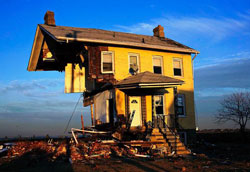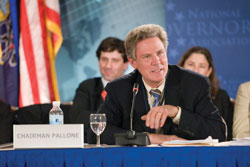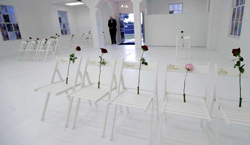United States Congressman Frank Pallone was the guest speaker in the class, “Sandy and the Political and Social Impact”, to discuss his personal experiences regarding Sandy recovery and the aftermath on Thursday, Feb. 20.
Patrick Murray, Director of the Polling Institute and the professor of the class said that when he designed the course, he wanted to have guest speakers from multiple angles to share their Sandy related experience with the students.
“We have been talking about the role of officials at all levels of government and the students have already heard from the New Jersey Senate President, the Monmouth County Sheriff, local mayors, and leaders from the non-profit world. Rep. Pallone gave us the perspective of the federal official who acts a conduit between his constituents and the federal bureaucracy,” said Murray.
Timothy Tracey, research associate at the Polling Institute, worked with Pallone prior to coming to the University. In the direct aftermath, Tracey traveled with the Congressman surveying the damage and disaster response.
“Seeing these efforts first hand helped me obtain an enhanced understanding of some of the immediate needs that often accompany a disaster, and how disaster response efforts demand efficient and effective communication. Travelling with Congressman Pallone in the immediate aftermath of Sandy and in the months after the storm afforded me the opportunity to understand some the most pressing issues facing the state of New Jersey as it began its longer-term rebuilding and recovery efforts,” said Tracey.
Pallone represents the sixth legislative district which stretches from Woodbridge to Asbury Park. Pallone said he was elected on environmental issues and related how the environmental factors contributed to Sandy.
Pallone spoke at length about climate change response. He said prevention is the key. The Congressman addressed those he said in the Republican Party who “deny the science.” He said the big question with climate change is, “How do you respond to clime change?”
Pallone spent time talking about how he was in awe of the humanitarian effort that followed the storm. “The volunteers help came on its own. It was neighbors or people in town, it was just overwhelming,” said Pallone. The Congressman said he was also evacuated like many others in the shore area. He said when the storm ended he went out to help people in any way possible. He spoke about Keansburg Middle School that became a shelter as well as the Multi-Purpose Activities Center (MAC) on the University campus. Pallone said that the University’s health center which he compared to a “mini-hospital for physical and psychological” patients. “Everyone geared up to help as best they could,” said Pallone.
Tracey said that as he travelled with the Congressman, he saw a lot of the behind-the-scenes work done by the Congressman and was happy that Pallone accepted the invitation to speak in the class. “Having Congressman Pallone come in to speak to Professor Murray’s class was, in my opinion, a great opportunity for the students to get an understanding of some of the behind the scenes efforts that go on in the immediate response to disasters,” said Tracey.
 The Congressman pointed out that the one bad thing he saw with regards to response was temporary housing. “FEMA (Federal Emergency Management Agency) was basically taking the position that if you had a place to put your head down you had temporary housing. Pallone said that even if neighbors or family offered to take in a victim of Sandy, it was considered temporary housing and Pallone said, “That was not a legitimate response.” Pallone did praise FEMA for most of its work. “Overall the response from FEMA and the community was overwhelmingly positive.”
The Congressman pointed out that the one bad thing he saw with regards to response was temporary housing. “FEMA (Federal Emergency Management Agency) was basically taking the position that if you had a place to put your head down you had temporary housing. Pallone said that even if neighbors or family offered to take in a victim of Sandy, it was considered temporary housing and Pallone said, “That was not a legitimate response.” Pallone did praise FEMA for most of its work. “Overall the response from FEMA and the community was overwhelmingly positive.”
Students were able to ask questions to the Congressman about specific areas that interested them regarding Sandy relief and the politics that followed. One student asked about the Sandy aid package that was passed by Congress, but nearly three months after the disaster. Pallone said that the NJ delegation responded quickly and wanted to get an aid package passed prior to the election. By Oct. 29th, 2012 an aid package had already passed the Senate and was sent to the House of Representatives. The bill was worth $60 billion, which Pallone compared to Hurricane Katrina which was worth $120 billion. Pallone said that House Speaker John Boehner promised to put the aid package up to a vote before the election which would be taking place, Nov. 6th, 2012. Pallone, along with the other NJ delegates and members of the NY delegate, received notice that the Speaker would not be posting the bill for a vote because “He wanted to be re-elected Speaker and Republican members in the west and south didn’t want to pass the bill with fear the aid would not be appropriated properly.” Pallone was disheartened by this action. “I’ve been in Congress a long time and I don’t recall a time not voting for a relief bill. They are like Mother Nature and apple pie. Of course you vote for it.” As the House of Representatives failed to pass the bill before the new session of Congress, the bill had to be re-submitted and posted but would have to be voted on in pieces.
This was when Pallone praised NJ Gov. Chris Christie for his help in getting the aid package passed but according to Pallone, the aid was put into multiple bills and pieces, making it difficult to get the money released. Pallone said that he felt it was risky giving one office all the funds to hold. The funds that have made news with the Governor’s office are Community Development Block Grants. The first block of funds were released on May 1st, 2013 but Pallone points out that it took too long to get the funds out to those who needed the help.
Pallone said another problem was the distribution of funds. The western and southern Republicans “Just didn’t trust us,” according to Pallone. The office responsible for distribution of funds was the NJ Governor’s office. Pallone’s critique about the block grants were that there was no criteria for people to follow and those who applied were often put on a waiting list for the funds but were never updated about their status.
Pallone also said another issue was how to bring tourism back to the Jersey Shore following Sandy. Pallone explained that the Governor’s office hired a group that included Gov. Christie in the commercial, which cost $25 million, while ignoring a group that cost less money but did not want Christie in the advertising. The Congressman was very critical about the lack of oversight regarding the Governor’s office and the fund allocation. He said, “The Governor proved those western and southern Republicans right about NJ.” Pallone wants more “strings attached” to the funding to avoid mishandlings that have been happening.
One student asked about the FEMA flood maps which Pallone said were looking to be passed prior to the storm which would raise insurance rates for those living in more flood prone areas. Pallone said that NJ Senator Robert Menendez is hoping to delay the rate increases but there has been no resolution to this issue.
Pallone was also asked about beach replenishment and whether it is an effective strategy. He said that $60 million of the funds from the block grant were supposed to go towards beach replenishment which includes rebuilding sand dunes and protecting residents and businesses from flooding.
“Right now, there are beach replenishment projects up and down the state coast from Sea Bright to Manasquan. In bay shore areas, it’s similar and also flood control projects are moving forward.” He continued, “Some critics say move away it’s hopeless but I can’t agree with that. We can use preventative measures.” He also said there is discussion about raising homes in NJ but the money has not come for possible grants for homeowners.
The Congressman spoke about the critics who said that the storm damage has been taken care of. “When talking about the Atlantic coast, you have a lot of tourism and summer homes and that has been another issue, how those with second homes are not entitled to any of the funding.” He continued, “The idea that a second home owner comes down for the tourism season and goes home but most people I represent, these are their first homes. I get mad sometimes because they will take a picture of Mantoloking which was devastated but mostly second homes but remember places like Woodbridge, Union Beach and Keansburg where most people live there year round.” Pallone’s main concern has been getting people back in their homes, “especially with the mess in temporary housing.”
Murray said he designed this class with the thought that Sandy affected political and social issues. “Considering all the research the Polling Institute has been doing on Sandy, I thought it only made sense to bring those experiences into the classroom as well. I developed these special topics to examine the whole concept of disasters as political and sociological events. With Sandy as a focal point, we have been able to bring in local speakers who participated in the response and recovery process first-hand. This gives students the unique opportunity to take the theory in their texts and see it in action through interaction with key actors in the Sandy process.”
Tracey agrees with Murray. “Having the Congressman in to speak about his experiences and his role in the response to Sandy brought this issue full circle, as the students were able to hear firsthand from the Congressman about his role, which served to complement what they have learned from reading and studying the results of the Sandy Recovery Survey,” said Tracey.
Adrian Palaia, a senior political science major, said that the issues regarding Sandy are a lot more complicated than people realize but was impressed with the Congressman’s ability to explain them. “The answer seemingly is not easy; good intentions, no matter how well wished, can be bogged down in politics and finical knit picking. And despite claiming progress, Pallone made it very clear; however more progress could happen if not for the opposing party.”
Bill Scarano, a senior political science major, said he was encouraged by the fact that Pallone took the time to speak to the class. “It was a unique opportunity for me to be able to ask sitting Congressman questions about policymaking and politicking.”
Pallone hoped that students took away the importance of climate change and the ways the federal government can make a positive difference. “We made progress but there is a long way to go. I’ve been critical of the Christie administration and a lot of the money hasn’t gotten out yet but people want to know why they are on a waiting list or what programs are available so there is a lot more that needs to be done.”
PHOTO TAKEN from asbarez.com
IMAGE TAKEN from nydailynews.com



